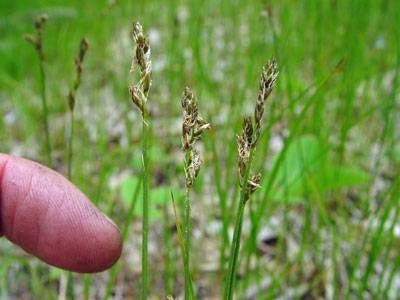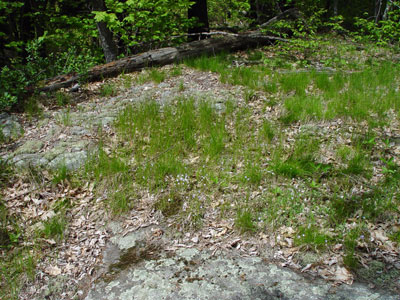DACF Home → Bureaus & Programs → Maine Natural Areas Program → Communities, Plants, and Animals → Rare Plants → Carex siccata

Carex siccata Dewey
Dry Land Sedge
- State Rank: S2
- Global Rank: G5
- State Status: Special Concern
Habitat: Dry, sterile or sandy soil, in open places in light shade [Old field/roadside (non-forested, wetland or upland)]
Range: Maine to Alaska, south to Rhode Island and New Jersey, Minnesota, and Arizona.
Aids to Identification: Members of this genus can be difficult to identify without careful examination of microscopic features and knowledge of general groups of species. Carex siccata is in the group Arenaria, which has short, unstalked spikes crowded densely together. The leaves do not form basal clusters, and the stems arise from long rhizomes. C. siccata is an erect sedge, growing singly or in small clumps, 15-40 cm tall, from tough rhizomes. The leaves are flat, 1.5-3 mm wide, and generally only growing from the lower quarter of the stem. The leaf sheaths are very thin, and there are generally 4-12 flowering spikes arranged in a cylindric cluster. Carex siccata is the only sedge in Maine with both wing-margined perigynia and stems arising from long rhizomes (the ovales are cespitose species).

Ecological characteristics: Sites in Maine where this sedge has been found are in dry, old fields in the early stages of succession.
Phenology: Fruits May - July.
Family: Cyperaceae
Synonyms: Carex foenea, sensu Fernald (1950) ( Carex foenea Willd. of Gray's Manual, Eighth Edition (Fernald 1950), but that name incorrectly applied).
Known Distribution in Maine: This rare plant has been documented from a total of 10 town(s) in the following county(ies): Androscoggin, Aroostook, Cumberland, Oxford, Sagadahoc, York.
Reason(s) for rarity: Unknown.
Conservation considerations: This plant is restricted statewide to southern Maine with a disjunt population in northern Maine, and known populations are vulnerable to conversion of their habitat to residential or commercial use.